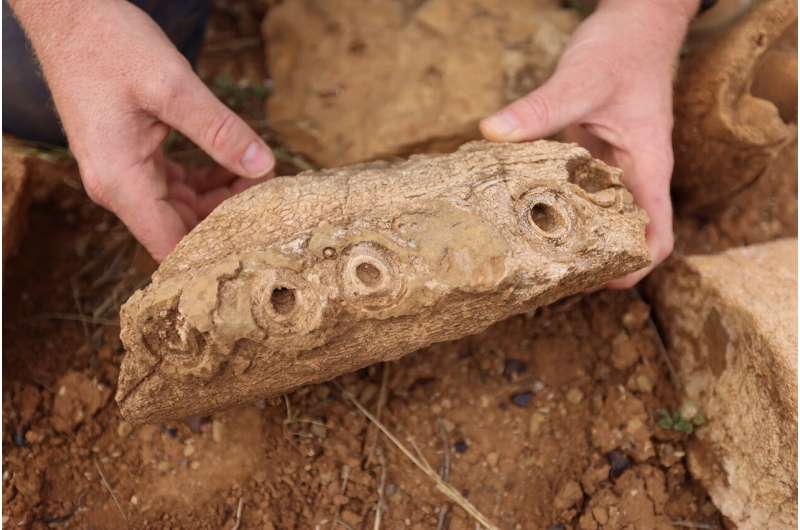Rare new fossil find the 'Rosetta Stone' of marine paleontology

Queensland Museum Network paleontologists have excavated Australia's first head and associated body of a 100-million-year-old long-necked marine reptile in what has been described as the Rosetta Stone of marine reptile paleontology.
The rare fossil was discovered by a Western Queensland station owner Cassandra, who, alongside two friends, Sally and Cynthia, form a fossil hunting trio called the "Rock Chicks."
The team of museum paleontologist's recently traveled to the remote site to collect the fossil of the elasmosaur, which is a plesiosaur that co-existed with dinosaurs.
Queensland Museum Network Senior Scientist and Curator of Paleontology, Dr. Espen Knutsen, who led the field trip said this would be the first known head and body of an Australian elasmosaur to be held in a museum collection.
"We were extremely excited when we saw this fossil—it is like the Rosetta Stone of marine paleontology as it may hold the key to unraveling the diversity and evolution of long-necked plesiosaurs in Cretaceous Australia," Dr. Knutsen said.
"We have never found a body and a head together and this could hold the key to future research in this field.
"Because these plesiosaurs were two-thirds neck, often the head would be separated from the body after death, which makes it very hard to find a fossil preserving both together, so we are using CT scanning to give us an insight into these magnificent animals."
Dr. Knutsen's research into Cretaceous marine reptiles of Queensland is supported by Project DIG, a partnership between Queensland Museum Network, BHP and BMA to unlock knowledge held in the collection for people across the world.
During the early Cretaceous period (between 145.5 and 65.5 mya), much of Queensland was covered in a vast, shallow sea (the Eromanga Sea) and fossil remains of the ocean's inhabitants, including marine reptiles, such as plesiosaurs and ichthyosaurs are commonly found across the state.
To help answer questions about their origins and ecologies, these new specimens along with modern analytical methodologies will help lift the veil on their prehistoric lives.
Minister for the Arts Leeanne Enoch said Queensland's remote regions continue to unearth unique and historic fossil finds that help reveal stories of our world from 100 million years ago.
"Congratulations to Dr. Knutsen, his team and the Queensland Museum Network for uncovering a globally significant palaeontological discovery of an almost complete elasmosaurus which is now located at its new home at the Museum of Tropical Queensland in Townsville," Minister Enoch said.
"The Queensland Government supports the Queensland Museum Network in its enthusiasm to bring to light new stories, and the recent selection of the museum's Muttaburrasaurus as our State's fossil emblem proves the enduring popularity of dinosaur narratives among so many Queenslanders."
"As an important keeping place for over 15 million cultural objects and natural history specimens, the Queensland Museum Network not only plays an integral role in driving innovations in science but its collections, research items and exhibitions are essential to preserving our history to help prepare future generations."
"As we lead up to the 2032 Olympic and Paralympic Games, important discoveries like this Plesiosaur, profile Queensland Museum's reputation, research and recognition on the global stage," Ms Enoch said.
Queensland Museum Network CEO Dr. Jim Thompson said this find would assist Dr. Knutsen and his team to paint a comprehensive picture of Queensland's Cretaceous marine reptiles.
"We now hold the only head and body of an Australian elasmosaur in the world, and this significant find will contribute greatly to vital research into Queensland's Cretaceous past," Dr. Thompson said.
"Queensland Museum Network holds one of Australia's most complete plesiosaur specimens, nicknamed 'Dave the Plesiosaur', which was discovered in 1999, however despite having 80 percent of its bones, it was missing a head, fins and tail tips."
"Through Project DIG, CT scans and 3D models will help us interpret data and potentially describe a new species."
This new fossil find could hold the key to unlocking the mystery around Australian plesiosaurs.
Along with the new skeleton, there were also several plesiosaurs and ichthyosaurs discovered and collected on the field trip, which will be transported to Townsville for preparation and further research.
Each year, the Rock Chicks—Cassandra, Sally and Cynthia, meet to search for fossils on the property and during this time have walked hundreds of kilometers on their quest to uncover fossils. During the years they have been thrilled with their finds which have included a plesiosaur each, a kronosaurus, ichthyosaur and several fish and turtles.
Cassandra said they are looking forward to their 2023 hunt and they have a motto of "let's keep the paleos busy".
"There are so many people who have helped get these amazing fossils to Queensland Museum including our friends, Tom and Sharon who helped us start digging two of the plesiosaurs," Cassandra said.
"And we wouldn't have been able to do this without the help of our little minions Bill, Mark, Remi, Pip, Gwen and Gordon."
Provided by Queensland Museum




















